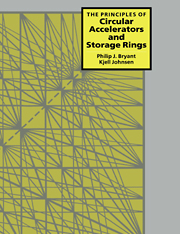Book contents
- Frontmatter
- Contents
- Foreword
- Coordinate system
- Symbols
- Useful Constants
- 1 Introduction
- 2 Basic concepts and constant-gradient focusing
- 3 Alternating-gradient focusing
- 4 Parameterisation of the transverse motion
- 5 Imperfections and resonances
- 6 Chromaticity
- 7 Longitudinal beam dynamics
- 8 Image and space-charge forces (transverse)
- 9 Coherent instabilities
- 10 Radiating particles
- 11 Diagnosis and compensation
- 12 Special aspects of circular colliders
- Appendix A Transverse particle motion in an accelerator
- Appendix B Accelerator magnets
- Appendix C Closed orbits
- Appendix D Phase equation
- Appendix E Vlasov equation
- References
- Index
12 - Special aspects of circular colliders
Published online by Cambridge University Press: 11 November 2009
- Frontmatter
- Contents
- Foreword
- Coordinate system
- Symbols
- Useful Constants
- 1 Introduction
- 2 Basic concepts and constant-gradient focusing
- 3 Alternating-gradient focusing
- 4 Parameterisation of the transverse motion
- 5 Imperfections and resonances
- 6 Chromaticity
- 7 Longitudinal beam dynamics
- 8 Image and space-charge forces (transverse)
- 9 Coherent instabilities
- 10 Radiating particles
- 11 Diagnosis and compensation
- 12 Special aspects of circular colliders
- Appendix A Transverse particle motion in an accelerator
- Appendix B Accelerator magnets
- Appendix C Closed orbits
- Appendix D Phase equation
- Appendix E Vlasov equation
- References
- Index
Summary
In the preceding chapters, much of the basic accelerator theory has been introduced and the ideas were so fundamental that they were often equally applicable to transfer lines and linear accelerators, as well as to circular machines, the central theme of this book. The present chapter will depart from this pattern and look briefly at some special aspects of circular colliders. This review will be rather superficial, but its aim is to make the reader aware of the problems and to provide references rather than to lay out detailed derivations of formulae.
From the introductory chapter, it is evident that high-energy physics was profoundly influenced by the inventions that made colliding beams feasible experimental tools. This did not happen suddenly. The main ideas on how to accumulate sufficiently intense beams to achieve significant interaction rates originated in the MURA Group in 1956, but considerable scepticism on the part of the physics community had to be overcome through practical demonstrations before the consensus of opinion turned in favour of colliders.
For electrons, many facilities were built and operated, but the highlights of this development were SPEAR and DORIS. Following their outstanding physics discoveries in the 1970s, all later proposals for electron machines were for colliders. LEP at CERN is the most recent and will probably remain the largest circular collider to be built for electrons.
- Type
- Chapter
- Information
- The Principles of Circular Accelerators and Storage Rings , pp. 285 - 308Publisher: Cambridge University PressPrint publication year: 1993



